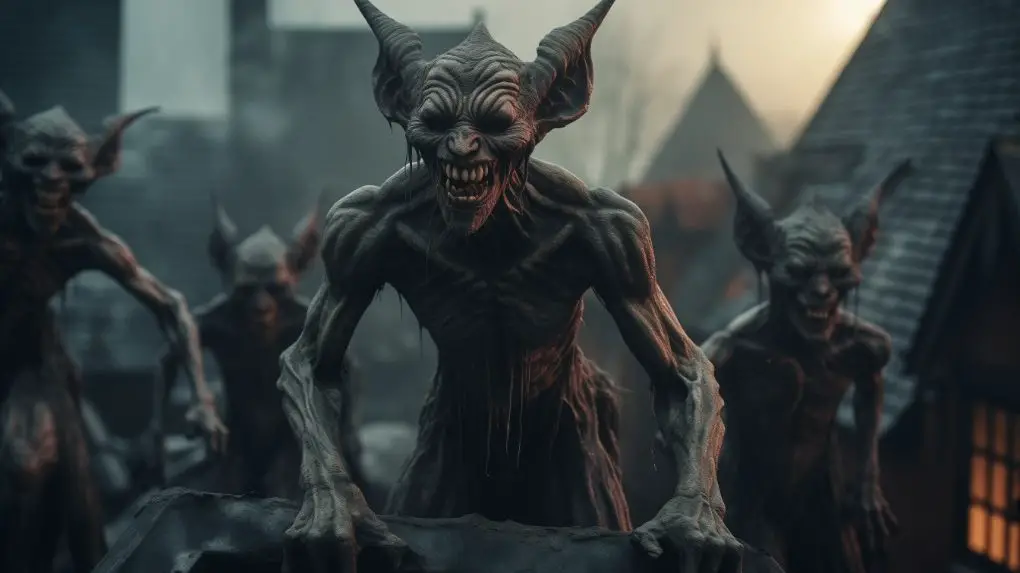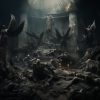In a world rife with tales of mighty men, and echoing with whispers of the pre-adamic race, the question looms large: where do demons come from?
From the haunting stories of fallen angels to the mysteries locked within the Dead Sea Scrolls, the unseen realm beckons with tales of spirits—some called evil, others angelic. These entities, with their ties to human women, have captivated the human mind since the dawn of human civilization.
The Bible speaks of a great dragon whose tail drew a multitude into rebellion, and literary masterpieces like John Milton’s “Paradise Lost” dive deep into the psyche of these celestial beings. As you journey through this exploration, you’ll uncover how demons originate, their impact on the world, and the eternal battle between good and evil. So, are you ready to delve into the shadows and unveil the mysteries of the supernatural? Read on.
The Origins of Demons
Fallen Angels: The Beginning
The universe, as described in various scriptures and traditions, is inhabited by a myriad of creatures. Among these are angels, often depicted as pure, divine messengers of God. However, a particular group of these angels rebelled against the divine order, leading to their fall from heaven. These “fallen angels” are what most Christians today identify as demons.
The Bible makes a compelling case for this narrative. In the book of Revelation, the “great dragon,” commonly identified as Satan or the devil, is depicted as drawing one third of the stars of heaven with his tail. These “morning stars,” as per biblical literature, are seen as angels. When Satan rebelled against God, one third of all the angels in heaven chose to follow him. Their rebellion against the divine led to their expulsion from heaven and their transformation into demons.
Understanding ‘Evil Spirits’
Across various scriptures and religious traditions, there are entities referred to as “called evil spirits.” These spirits are different from the angels God created. While angels were created to serve and glorify God, these entities have a distinct purpose. Their primary goal is to oppose, deceive, and bring chaos among living creatures. The descent of a fallen angel, who chose rebellion over obedience, led to the creation of these malevolent entities.
The Hebrew Bible, also known as the Old Testament, provides numerous accounts of these spirits. They were not always tied to fallen angels but were considered disembodied spirits, sometimes of the wicked dead. Their influence varied, from causing ailments and madness to leading individuals and nations away from God.
Dead Sea Scrolls: An Insight into Demonic Beings
The Dead Sea Scrolls, discovered in the mid-20th century, offer a unique glimpse into the spiritual beliefs of Jewish sects around the second century BCE to the first century CE. Among these ancient texts, there are references to demons, fallen angels, and evil spirits. The scrolls speak of “Beliar” or Belial, an entity considered the leader of the forces of darkness, opposing God and His righteous ones.
Moreover, these texts delve into the lore of the “Watchers,” angels who descended to earth and bore children with human women. These unions resulted in the Nephilim, giant offspring described in the Book of Genesis. These beings, half human and half angelic, were believed to have wreaked havoc upon the earth, leading God to cleanse the world with the Great Flood.
Jesus Christ and Demon Encounters
The New Testament is replete with episodes of Jesus Christ confronting and exorcising demons. These encounters highlight the tangible reality of these entities in the world of the first-century Judea. Jesus’s authority over these spirits affirmed his divinity and mission on earth. The demons recognized Him, often exclaiming his true nature as the Son of God before being cast out. Through His actions and teachings, Jesus demonstrated the nature of these beings and their purpose: to deceive, harm, and lead humans away from God’s light.
The Nature of Demons
Demons vs. Angels: Key Differences
While angels and demons originate from similar heavenly origins, their purposes, behaviors, and allegiances are polar opposites. Angels serve as God’s messengers and protectors of humans, always seeking to fulfill God’s will. Demons, on the other hand, are fallen angels who, after rebelling against God, seek to deceive, destroy, and turn humanity away from their Creator.
In scripture, angels often appear in human form to deliver messages or assist God’s people. Demons, conversely, are often portrayed as seeking human bodies to possess, as they lack a physical form of their own. This distinction highlights their parasitic nature, contrasting the benevolence of angels.
The Physical Appearance: Half Human, Half Angelic?
The Bible doesn’t provide explicit descriptions of demons’ appearances outside of possession scenarios. However, certain passages, particularly those concerning the Nephilim, suggest that unions between fallen angels and human women produced giant offspring. These beings, being half human and half angelic, possibly bore unique features.
Outside of scripture, cultural and mythological depictions of demons vary widely, from horned creatures to monstrous beasts. While these are products of the human mind and artistic interpretation, they reflect the universal fear and intrigue surrounding these entities.
Demonic Possession: The Power to Take Over the Human Body
One of the most chilling aspects of demonic activity recorded in the Bible is possession. Demons seek out human bodies to inhabit, exercising control over their host and often causing physical and mental torment. The New Testament provides multiple accounts of Jesus expelling demons from afflicted individuals. These possessions were characterized by violent behaviors, superhuman strength, and an aversion to the holy.
The reasons for demonic possession vary. Some biblical scholars argue that possession is a means of corrupting the human spirit, while others see it as an act of spite against God, defiling His most cherished creation.
The Enigmatic Tale of the Pre-Adamic Race
There are theories, although not mainstream, suggesting the existence of a “pre-adamic race.” These were beings that existed on the whole earth before Adam, the first human man, and the human woman, Eve, were created. Some believe that the remnants of this race, after facing God’s judgment, might have turned into spirits with their own purposes, further populating the realm of the supernatural.
Also read What Do Demons Look Like
The Historical Perspective
Human Women and the Influence of Evil Angels
The narrative of fallen angels mingling with human women is one of the most intriguing in biblical lore. The Book of Genesis briefly mentions the “sons of God” taking human wives, resulting in the Nephilim, a race of giants. These unions between the spiritual and the earthly realms produced beings that upset the natural order, leading to widespread corruption.
Such narratives, found in other ancient cultures too, often serve as cautionary tales about the dangers of crossing boundaries set by the divine.
The Mighty Men and the Giants
Biblical literature speaks of “mighty men” of old, renowned for their strength and prowess. These individuals, also linked with the Nephilim, were said to be giants, “producing giants” in their lineage. There’s a belief that the mingling of the divine and the earthly, as seen in the unions of fallen angels and human women, gave rise to these mighty beings. Their stature and power were unparalleled, marking them as distinct entities on the earth.
Demons in the Hebrew Bible and Old Testament
The Old Testament offers a more abstract view of demons compared to the New Testament. Instead of direct confrontations, these entities often act as adversaries or tempters, leading people away from God. They are sometimes seen as agents of punishment, executing God’s wrath upon those who stray.
For instance, the Bible tells of the evil spirit that tormented King Saul after he disobeyed God’s command. While not explicitly a demon in the New Testament sense, this spirit’s role was to chastise the king for his transgressions.
New Testament Insights: Jesus, Demons, and Deliverance
The New Testament, particularly the Gospels, contains numerous accounts of Jesus’ encounters with demons. These narratives underscore the real and present danger these entities posed during that period. Whether manifesting as physical ailments, mental disturbances, or supernatural knowledge, demons recognized Jesus as a direct threat to their dominion on earth.
Through His ministry, Jesus showcased His power over these beings, offering deliverance to the possessed and teaching His disciples the means to combat such evil.
Related: How Many Demons Are There
Demon Worship and Its Impact on Human Civilization
Bastard Spirits and Their Role
Ancient civilizations often recognized the existence of various spirits, some benevolent and others malevolent. Among these were the “bastard spirits,” believed to be the disembodied spirits of the Nephilim who perished in the Great Flood. These spirits, neither wholly angelic nor entirely human, were said to wander the earth, causing chaos and seeking bodies to inhabit.
Historical texts and traditions describe rituals, offerings, and incantations aimed at appeasing or warding off these spirits. Their liminal status—caught between the celestial and terrestrial realms—made them subjects of both fear and reverence.
The Gods of Other Nations: Evil Deities or Demons?
The Bible frequently warns the Israelites against worshiping the gods of other nations. Were these gods merely constructs of human imagination, or were they manifestations of demonic entities seeking worship? Many biblical scholars posit that these foreign deities were, in fact, demons presenting themselves as gods, leading people astray from the one true God.
The Apostle Paul, in his letter to the Corinthians, warns that those who offer sacrifices to idols are, in essence, sacrificing to demons. This perspective underscores the belief that behind every false deity lurks a demonic presence, eager to deceive and ensnare.
Demons in Popular Culture
Paradise Lost: John Milton’s Take on Fallen Angels
John Milton’s epic poem, “Paradise Lost,” offers a gripping retelling of the fall of Satan and his cohorts. While not canonical, Milton’s portrayal of these fallen angels as tragic figures, particularly Satan, has influenced Western perceptions of demons.
In Milton’s narrative, Satan is a charismatic yet doomed figure, choosing to rebel against God’s sovereignty. His rallying cry, “Better to reign in Hell than serve in Heaven,” captures the pride and defiance that led to his downfall. Through “Paradise Lost,” Milton delves into the psyche of these fallen beings, exploring their motivations, regrets, and insatiable thirst for revenge.
Demons in Biblical Literature
Throughout biblical literature, demons serve as both adversaries and instruments of God’s judgment. From the serpent in the Garden of Eden to the Legion that Jesus exorcised into a herd of swine, these entities are ever-present, always seeking to undermine God’s plans and His creation.
Yet, their portrayal isn’t one-dimensional. The Bible also presents demons as beings aware of their eventual fate. They recognize Jesus as the “Holy One of God” and fear His power. This dual representation—as both cunning adversaries and fearful entities—adds depth to their characterization in biblical narratives.
Don't miss Exploring the Fascinating World of Ghosts in Literature
Dealing with Demons: A Christian Perspective
The Holy Spirit: Protection Against Evil
For Christians, the Holy Spirit serves as a shield against demonic influences. As believers receive the Holy Spirit, they’re equipped with discernment, allowing them to recognize and resist demonic activity. Paul’s letter to the Ephesians speaks of the “armor of God,” a spiritual toolkit that includes faith, truth, and salvation, ensuring protection against the devil’s schemes.
What the Bible Tells Christians Today
Today’s Christians are advised to be vigilant, recognizing that they’re engaged in spiritual warfare. The New Testament authors frequently remind believers of the ever-present danger posed by demons and encourage them to remain steadfast in their faith. By grounding themselves in scripture, prayer, and communal worship, Christians can fortify themselves against the snares of the evil one.
Exorcisms and Driving Out Demons
While Jesus and His disciples performed exorcisms, driving out demons from the afflicted, the practice remains controversial among Christians today. Some denominations view exorcism as a necessary ministry, while others approach it with skepticism. Regardless of stance, the act underscores the belief in the real and tangible influence of demons in the world.
You may also like How to Get Rid of Ghosts Tips and Tricks for Banishing Spirits
The Relationship Between Demons and the Unseen World
Demons: Inhabitants of the Spiritual Realm
Demons, as spiritual entities, belong to the unseen world. This realm, while imperceptible to the human eye, plays a pivotal role in religious and metaphysical beliefs. The spiritual domain is where battles between good and evil occur, influencing the events and fates of the earthly realm.
Scripture often alludes to this invisible battleground. The book of Daniel, for instance, describes a scenario where the angel dispatched to deliver a message to Daniel is hindered by the “prince of Persia,” a spiritual entity or demon representing the Persian Empire. Such instances underscore the intertwined nature of the seen and unseen worlds.
The Anointed Cherub: A Glimpse into the Pre-Fall World
Ezekiel’s description of the “anointed cherub” provides insights into the state of the spiritual realm before rebellion tainted it. This cherub, often associated with Satan, was initially created perfect in beauty and wisdom. Positioned on the holy mountain of God, he was blameless until wickedness was found in him.
His rebellion, driven by pride, disrupted the harmony of the spiritual realm, leading to the emergence of demonic entities. The transition from an anointed guardian cherub to the adversary of God paints a vivid picture of the dynamics within the unseen world.
Demons and Their Interaction with the Human Mind
Temptation: The Subtle Art of Demonic Persuasion
Demons excel in manipulating the human mind, introducing doubts, and enticing individuals to sin. The devil’s temptation of Jesus in the wilderness serves as a prime example. Using scripture itself, Satan tried to persuade Jesus to act against His divine nature and mission.
This event demonstrates the nuanced ways in which demonic entities can influence thoughts, even using truth deceptively to achieve their goals. The human mind, with its fears, desires, and vulnerabilities, offers fertile ground for such entities to sow seeds of discord and rebellion against God.
Modern Perspectives: Psychological vs. Spiritual
The modern age, with its emphasis on science and psychology, often views reports of demonic possession or influence as mental health issues. Disorders, traumas, and psychosomatic conditions are frequently presented as explanations for behaviors traditionally attributed to demonic activity.
However, many religious practitioners and believers maintain that while psychological factors can account for some cases, genuine instances of demonic interference still occur. Discerning between the two requires wisdom, spiritual insight, and, often, collaboration between religious and medical professionals.
Related Article A Guide to Ghost Hunting Equipment and Techniques
Demons in the End Times
The Dragon Stood Ready: Revelations and the Final Battle
The book of Revelation paints a vivid picture of the end times, where demons play a pivotal role. The “great dragon,” identified as Satan, rallies his demonic forces for a final confrontation against God and His angels.
This prophetic vision, filled with symbolism, describes events that transcend time and space, encapsulating the cosmic struggle between good and evil. Demons, alongside their leader, wage war against heaven, seeking to establish their dominion over the whole world.
The Pull of Possession
Throughout history, stories abound of demons seeking to “possess people.” Unlike angels, who respect human free will, these entities desire to inhabit human bodies for their own purposes. This act of possession allows them to experience the physical realm directly and exert their influence more tangibly.
Final Judgment: The Fate of Demons
Scripture is clear about the eventual fate of demons. The lake of fire, initially prepared for the devil and his angels, awaits them. Their time is limited, and their defeat is certain. The book of Revelation states that Satan, the beast, and the false prophet will be thrown into the fiery lake, marking an end to their reign of deception and terror.
The Unseen World: Exploring the Supernatural
The supernatural realm, often referred to as the unseen world, remains a topic of intrigue, speculation, and spiritual importance. Rooted in ancient texts and carried forward by myriad cultures and religions, the concept posits that beyond our tangible existence lies another dimension—home to beings, forces, and dynamics that influence our world.
The Great Flood, Giant Offspring, and Their Connection to Demons
The Biblical account of the Great Flood is a tale of divine judgment, brought upon the earth due to humanity’s wickedness. Yet, nestled within this narrative is the mysterious mention of the Nephilim, giant offspring born from the unions of the “sons of God” and “daughters of men.” These beings, considered to be half-human and half-angelic, dominated the pre-Flood world with their might.
Some interpretations posit that when these hybrid beings died in the Flood, their spirits, unable to ascend to heaven or find rest on earth, became the demons we’re familiar with today. These restless spirits, neither entirely celestial nor fully terrestrial, seek to influence, torment, and sometimes possess humans, longing for a corporeal existence they lost.
The Dragon Stood: Satan, the Great Dragon, and One Third of the Angels
Revelation 12 provides a captivating vision of a cosmic battle. The great dragon, identified as Satan, is depicted as rebelling against God, leading a revolt with one third of the angels. This celestial war, while veiled from human eyes, had significant ramifications for both heaven and earth.
Satan’s rebellion led to his expulsion from heaven, and with him, the fallen angels who chose to side against God. These fallen entities, embittered by their defeat and exile, seek to undermine God’s plans, especially as they pertain to humanity. The dragon, ever the adversary, endeavors to lead the whole world astray, using his demonic minions to sow discord, deception, and destruction.
Conclusion
Demons, Humans, and the Battle for the World
Demons, as revealed through ancient texts and human experiences, are not mere myths or allegories. They’re very real entities, operating in the shadows, always striving to further their agenda. Humanity, caught in the crossfire of this cosmic conflict, often finds itself at the forefront of demonic attention.
Yet, the narrative isn’t one of hopelessness. Throughout history, many have testified to the protective power of faith, the interventions of benevolent spiritual beings, and the hope that good ultimately triumphs over evil. The ongoing struggle underscores the significance of the human soul and the lengths to which both heavenly and demonic forces will go to claim it.
While the presence of demons is a sobering reality, it also serves as a testament to humanity’s intrinsic worth in the cosmic scheme. The battle for the world, and more crucially, for each human soul, rages on. It’s a battle that calls for awareness, vigilance, and unwavering faith in the face of the unseen.



